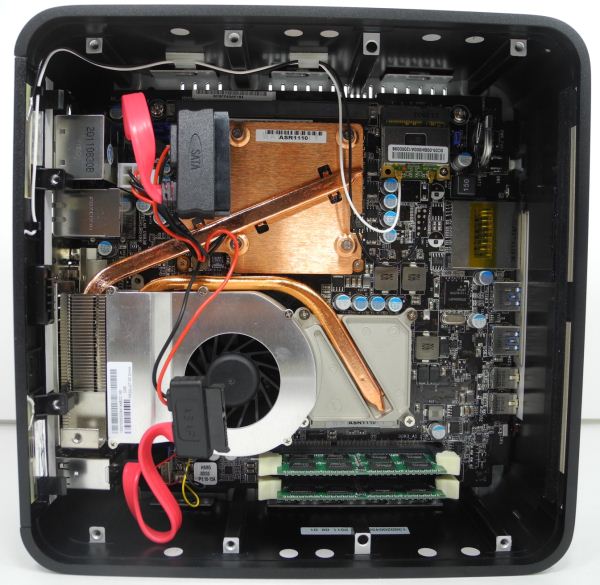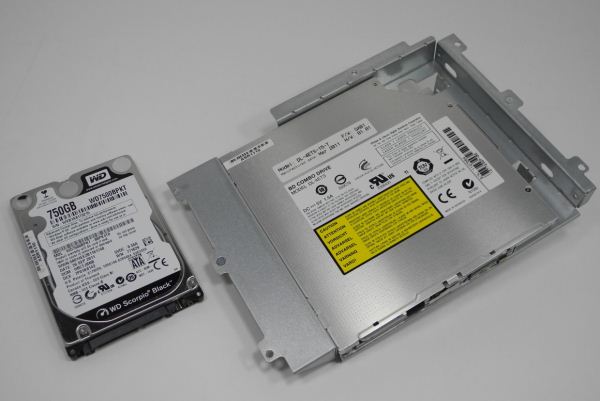ASRock's High-End Vision 3D 252B HTPC Review
by Ganesh T S on May 7, 2012 6:15 AM EST- Posted in
- Home Theater
- Sandy Bridge
- HTPC
- GT 540M
- NVIDIA
The ASRock Vision 3D 252B is primarily built out of notebook components, and it is not possible for the average enthusiast to build such a system with off-the-shelf components.
Motherboard & Chipset : mini-ITX Intel HM65-MXM
The motherboard used in the Vision 3D series is based on the Cougar Point Intel HM65 chipset. The 2 SATA 6 Gbps ports are available as headers on the motherboard, while one SATA 3 Gbps port is made available as an eSATA3 port. Another SATA port is available as a header on the motherboard (it is connected to the Blu-ray drive).
The mini PCI-E slot is taken up by the Atheros based AzureWave WLAN module. The two sides of the Vision 3D chassis are used as antennae. The two DIMM slots are on the right side of the board, next to the CPU. There is also a MXM slot in which the GT 540M MXM module is plugged in.
CPU : Intel Core i5-2520M
The Core i5-2520M is a 35W TDP processor belonging to the 32nm Intel Sandy Bridge family. Clocking in at 2.50 GHz, it is capable of going up to 3.2 GHz for a single core and 3.0 GHz for both the cores in turbo mode. 3MB of Intel Smart Cache is shared between the two cores and the integrated GPU.
Integrated GPU : Intel HD Graphics 3000
The integrated GPU in the Sandy Bridge processors come in two varieties, namely, HD Graphics 2000 and HD Graphics 3000. The Core i5-2520M uses the latter. It has a base frequency of 650 MHz, and is capable of going up to 1.3 GHz in stressful conditions. It supports full 3D video capabilities, QuickSync and WiDi. However, WiDi is not supported by the CoreHT 252B. WiDi makes sense for laptops, but not much for SFF HTPCs. So, we don't fault ASRock for avoiding this feature. Since we also have a discrete GPU in the system, Virtu from LucidLogix is necessary for users to be able to take advantage of the HD 3000's capabilities. The Vision 3D 252B's BIOS comes with a license for Virtu. Most users will be using Virtu to take advantage of QuickSync.
Discrete GPU : NVIDIA GT 540M
The MXM module in the Vision 3D 252B is the NVIDIA GT 540M. This is a slight step up from the GT 425M used in the first generation Vision 3D 137B.
DRAM : ASInt 2 x 4GB DDR3-1333
ASRock has used a relatively new memory vendor in ASInt for the CoreHT 252B. The memory chips operate with a 9-9-9 CAS latency.
Hard Disk : Western Digital Scorpio Black 750GB 7200 rpm 2.5"
The 750GB Scorpio Black is one of the best reviewed hard disks in its class. It has been reviewed to have upto 120 MBps sequential read speeds.
The hard disk is a good choice with respect to the price - performance ratio for the ASRock Vision 3D 252B.
Optical Disk Drive : Philips Lite-on Blu-ray / DVD RW Slot Loading Drive
The ASRock Vision 3D 252B ships with the Philips Lite-on DS-4ETS BD Combo Drive. This is a slot loading drive similar to the one in the first generation Vision 3D, befitting a high end premium HTPC.
MCE Remote
One of the shortcomings of the ASRock HTPCs when compared with something like the Zinos from Dell is the absence of a wireless keyboard / mouse combo. However, ASRock does take care to ensure the presence of an IR receiver in the system and also bundle a MCE remote.
The MCE remote bundled with this system is the same as that of the CoreHT 252B. When the CoreHT 252B shipped with the same remote as the Vision 3D first generation unit, we thought the second generation Vision 3D would also get a step up. Unfortunately, that is not the case.
As we have noted before, the quality of the MCE remote is a big letdown. The keys are quite small and the unit feels cheap in the hand despite being pretty decent in appearance.
In the next few sections, we will take a look at the performance of the ASRock Vision 3D 252B.













60 Comments
View All Comments
BPB - Monday, May 7, 2012 - link
I am planing on doing the same thing. Been trying it out with my notebook and like the way it's working with my HDHomerun Prime, so it looks like I'm losing a notebook but gaining an HTPC that's going to use little power and can be unplugged and still used as a laptop when needed. Now I have to get an good size external HDD and I am set. The nice thing is when the notebook is in use as a notebook I can use my desktop PC and Xbox combination to record/watch TV.IntoxicatedPuma - Tuesday, May 8, 2012 - link
Yeah you could easily by an Asus U36 series for around $600-$650 with similar performance. I don't know that I agree with the article about desktop CPU's being noisy and hot. For half the price of that machine, you could build an H61 machine with a 2100T, same hard drive, and equivalent video card that was about the same size and used about the same amount of power, and wouldn't run any hotter or be any noticeably louder.yottabit - Monday, May 7, 2012 - link
Regarding the line:"We are a little worried about the full loading power consumption being more than what the power supply is rated for"
I'm not sure this is true since you are comparing apples to oranges. Power supplies are typically rated for DC OUTPUT but you are comparing the rated DC output to the draw at the wall. Assuming the PSU is 80% efficient, then a 90W rating should equal approximately 90W/0.8= 112.5 W at the wall. Just a food for thought, I see this error commonly.
ganeshts - Monday, May 7, 2012 - link
Thanks for the pointer. The power consumption of > 109 W is still more than that of the first generation Vision 3D which was 82 W. This still makes us worried. I am trying to determine the power efficiency of the PSU (Delta Electronics ADP-90CD DB).Angengkiat - Monday, May 7, 2012 - link
Hi Ganesh,Any idea what software to use if we want to play 3D nicely on the machine, cos I am using TMT5 but it does not seem to be able to display the same 3D effects compared to a dedicated bluray player?
Thanks!
EK
ganeshts - Monday, May 7, 2012 - link
That is a bit surprising. TMT 5 has full 3D Blu-ray support. Maybe the 3D Blu-ray player is assuming some settings which have to be configured in TMT 5 (like the depth of view). Also, did you run the NVIDIA 3D display setup?MichaelD - Monday, May 7, 2012 - link
$1.2K. REALLY? That's just nuts. Nice piece of hardware, but not worth what they're asking for it. Plus at this pricepoint there had better be an SSD in there. At least a 64GB for the OS and programs. There's enough room in the chassis for a second 2.5" drive. They should've done a 2-drive, SSD/HD combo at this price.ganeshts - Monday, May 7, 2012 - link
Agreed :) I have recommended the same to ASRock.tctc - Monday, May 7, 2012 - link
Hi - couple of questions about the twin GPU configuration1. What determines which GPU is used by a particular application?
2. Can the iGPU be disabled so that only the NVIDIA 540 is used?
Regards,
tctc
ganeshts - Monday, May 7, 2012 - link
Yes, this is handled by Virtu. If you don't install Virtu, the 540M is the only one that is used. You need Virtu to choose applications for which the iGPU gets used (commonly MediaConverter / any app for which you want to use QuickSync)